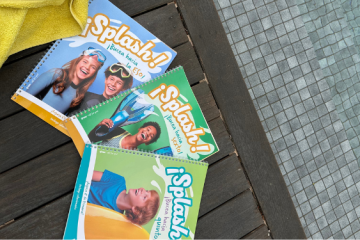Depending on the mood of the class, the teacher can decide if the children might benefit from running around with a flashcard game or if they need to focus/ settle down with a calmer flashcard activity.
They also have the potential to be used in whole group activities, pair-work or team games. While we tend to think of flashcards as a resource we use with infant or primary levels, they are equally useful in low level adult classes! Here are some animal flashcard activities that demonstrate how we can use flashcards in class.
Flashcard Resources
1. PEEK a BOO. Play this game after showing the flashcards one by one and when the pupils are familiar with the vocabulary. Hold the back of one flashcard in front of another flashcard which has the image. Slowly slide the image up bit by bit. You can make it more fun by sliding it back down again so pupils only see the image for a second or two. Slowly reveal the card until the pupils can identify what is.
2. TELEPATHY. This is a nice little ‘calmer’. Tell the pupils that you are thinking of one of the cards and concentrating on the image. Ask them to concentrate and see if they can read your mind and see your animal. They then ask ‘is it a ……… ‘ to which you respond ‘yes, it is’; or ‘no, it isn’t’; until a pupil identifies the animal you are thinking of.
3. MEMORY. There are various memory games which can be played with flashcards:
- Now you see me
Put the flashcards on the floor or stick them on the board. Ask the pupils to memorise them for ten seconds. Ask them to close their eyes, no peeping! Take away one of the cards. The pupils have to shout out which animal has disappeared.
Stick the flashcards in a row on the board and drill the animals. Ask the pupils to turn around. Take away one of the animals. The pupils drill the animals again remembering the name of the animal that is no longer there. Continue until all the animals have been removed and the pupils are drilling all the animals from memory.
- Cheetah
If you want to bring in a ‘run around’ element, divide the pupils into two teams. On the board have two sets of flashcards in a row, one for each team. On either side of the room (one for each team) dotted around, stick up the same animals. Each team stands at the front of the class and memorises the animals for ten seconds. They then turn around. Take away the same or a different animal from each row.
Each team looks at the board and tells ‘the cheetah’ (the runner in each team, who changes each time) which animal is missing. The cheetah then has to hunt the missing animal from his or her side of the room, run and fetch it and stick it in the missing place. The first runner to stick up the word correctly wins a point. You then play the game again with a different runner in each team.
- Fishes (Pelmanism)
Put two sets of flashcards on the floor face down, or stick them on the board. In two teams the pupils have to make pairs picking one card and then another. Over time they will remember where the cards are placed to make the pairs. The team with the most pairs wins.
4. ON OUR MARKS, GET SET, GO (board run). Divide the pupils into two teams standing one behind the other in a line in front of the board. On two different sides of the board put two rows of flashcards. Shout out an animal. The first person in each team has to race to the board and be the first person to touch the flashcard. The second person in each team then steps forward to race.
5. TARGET. The same as above except the teams instead of racing to the board have to throw a soft ball (from a distance) and hit the corresponding flashcard.
6. HOP, SKIP and JUMP. The teacher sticks various flashcards around the room. He or she then instructs the children to, for example, hop to the tiger and the pupils go to the animal in the way the teacher has instructed.
7. SNAP. In pairs the pupils have a set of flashcards each and play SNAP saying the card out loud as they place it. One player could have the images and the other player could have the words, as long as the children are familiar with the pronunciation before being exposed to the written word.
8. BINGO. Depending on the number of flashcards the children draw a grid, for example 3 by 3. In each square they write the name of one of the flashcard animals or draw it quickly. The teacher then shows a flashcard one by one and the children cross out the ones they have. If they get 3 in a row they can shout ‘LINE’. If they have all 3 they shout ‘BINGO’.
9. SING SONG or nursery rhyme flashcards with actions:
- Row your boat
Teach the children the song ‘Row, row, row your boat gently down the stream. If you see what I can see, don’t forget to scream’. Before class the teacher sticks various flashcards in different places around the classroom. The children sing the song with rowing boat actions. At the end of the song the teacher shouts out the name of an animal and the children have to point to where it is in the classroom.
- Farmer, Famer
Teach the children ‘Farmer, farmer can we cross your field of golden corn’. The children are all in a line at one end of the classroom with a different animal flashcard he or she has chosen from the pack. They sing ‘Farmer, Farmer…..’
The teacher (or a pupil once they know how to play) is the farmer. The farmer answers with ‘yes, you can if your animal is a snake’ for example. It is better if the farmer randomly chooses the cards from the pack each time. If the pupils have more language he/she can give permission saying for example, ‘yes, if your animal has big ears’. Each time the farmer says their animal they can move forward a step. The first student to reach the farmer is the winner.
- What’s the time Mr.Wolf? or Whats your animal Mr. Wolf?
Similar to the above except this time the children chant ‘What’s your animal, Mr. Wolf’ and the student who is closest to Mr. Wolf when Mr. Wolf turns round is caught and loses.
10. WHO ARE YOU?/ WHO AM I? It is a good to practise structures and extra animal vocabulary for example; wings, fur, claws, fins. A little bit like the game ‘famous people’ and can be played in two ways:
- Give a card to a student which is TOP SECRET. The rest of the class have ten turns to guess what the animal is. For example, Are you big?/ Have you got 4 legs?/ Can you swim?/ Do you live in the jungle? The student who has the animal flashcard gives the appropriate yes or no short answer until someone guesses the animal. If you like you can set a maximum of 10 questions. This game can be played as a whole class activity with one person at the front or in pairs.
- Alternatively, you can give each child an animal flashcard and they have to find out who they are by asking the question ‘Am I a …….?’ They can play in pairs or in groups. If the pupils play in groups (for example of 4), the pupils take it in turns to ask a question one by one and remember the answ ers until they guess who they are.
While some books come with flashcards for example Ladybird Readers, there are also some great sites where you can download subject vocabulary flashcards.











Sense comentaris